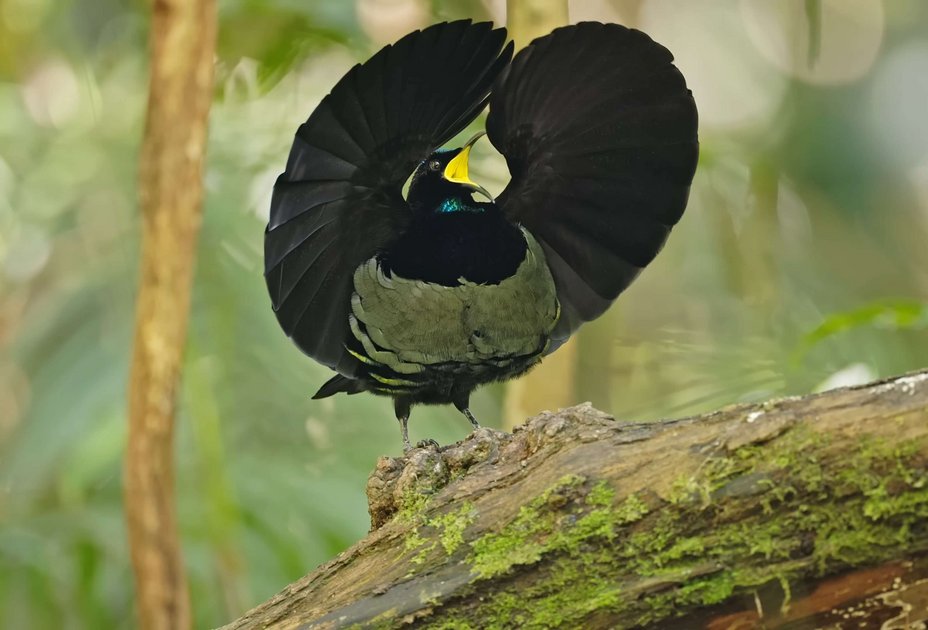- Home /
- University /
- Infoservice /
- Press Releases /
- Seduced by dance: Mate Choice in Riflebirds
Research
Seduced by dance: Mate Choice in Riflebirds
In the rainforests of Australia, a fascinating spectacle unfolds: the males of the Victoria's riflebird, a bird species from the bird-of-paradise family, perform impressive courtship dances to capture the attention of females. A new study by Vetmeduni in collaboration with Sapienza University of Rome has investigated how these dances are structured and what role they play in mate selection.

The dances of Victoria's riflebirds consist of rhythmic movements in which the males alternately flap their wings, move their heads, and display their colorful throats. Particularly intriguing: the dances start slowly, gradually accelerate, and culminate in a phase where the tempo remains consistently high—the so-called "tempo plateau." Researchers found that only dances that reached this plateau actually led to mating. Females seem to pay special attention to the males' peak performance.
"We found that higher plateau tempos are clearly associated with mating success," explains Thomas MacGillavry from the Konrad Lorenz Institute of Ethology at Vetmeduni. However, reaching this phase is a challenge. The dances must last at least 16 seconds to hold the females' attention. "Capturing the females' attention is the key to success," MacGillavry adds.
A Performance Test for the Males
The study, conducted over two breeding seasons, analyzed 713 courtship interactions from twelve males. It became evident that females base their mating decisions less on the general quality of the male and more on the performance in individual dances. Fast display tempos seem to excite the females the most. The dances thus serve as a kind of "performance test," where the males demonstrate their abilities. Interestingly, the researchers also found evidence that the acceleration of tempo and the rhythmic variability of the dances might play a role. However, these effects were less pronounced than the importance of the tempo plateau.
"The sensory development of sexual signals could be a central factor in mate choice, driving the evolution of complex dance displays in animals," says Leonida Fusani, who has been researching the topic of "Comparative Aesthetics" since 2014 at Vetmeduni and the Department of Behavioral and Cognitive Biology at the University of Vienna.
Insights into the Evolution of Complex Courtship Rituals
The findings not only provide insights into the behavior of Victoria's riflebirds but also into the evolution of complex courtship rituals. They show how rhythm and dynamics are used in the animal kingdom to capture attention and ensure mating success. The courtship dances of Victoria's riflebirds are thus not only an aesthetic spectacle but also a prime example of sophisticated communication in nature.
A Look into the Future
According to the study's authors, further research is needed to understand the exact mechanisms influencing mate choice. Particularly exciting would be to investigate the reactions of females to targeted changes in the males' dances. Such experiments could help to better understand the role of rhythm, tempo, and visual signals.
The article "Dancing male riflebirds create a dynamic sensory trajectory that guides female choice" by Thomas MacGillavry, Yannick Jadoul and Leonida Fusani was published in Current Biology.
Scientific article
The project was funded by the FWF DK Grant "Cognition & Communication" W1262-B29.
Scientific contacts:
Konrad-Lorenz-Institut für Vergleichende Verhaltensforschung (KLIVV)
Veterinärmedizinische Universität Wien (Vetmeduni)
Leonida Fusani, PhD
leonida.fusani@vetmeduni.ac.at
Thomas MacGillavry MSc.
Thomas.Gillavry@vetmeduni.ac.at